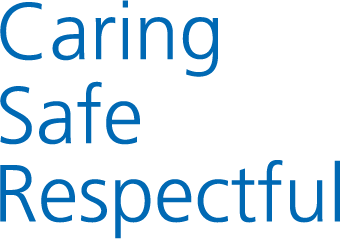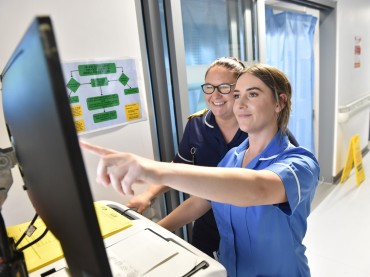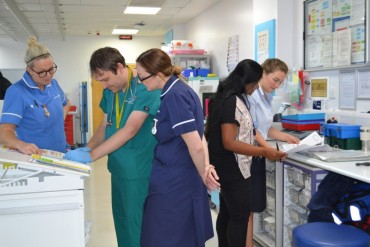What is anxiety?
Anxiety is a normal healthy reaction which happens to everyone in times of danger, stress or as a reaction to particular life events.
Feelings of anxiety can vary from mild anticipation to extreme terror, as if something dreadful is going to happen. Moderate amounts of anxiety are useful in our everyday lives but can become a problem if out of proportion.
Anxiety management techniques can be used to help control your anxiety. This anxiety support tool will cover ‘Progressive muscle relaxation’ and ‘Breathing retraining.’
It is also important to ensure that you have a well-balanced healthy diet. Avoiding blood sugar fluctuations and reducing caffeine intake can help reduce symptoms of anxiety
When we are worried or frightened, the body’s nervous system reacts by releasing a hormone called adrenaline. This causes physical symptoms resulting in the body’s ‘fight or flight’ response.
Physical symptoms of anxiety may include:
• Increased heart rate
• Increased blood pressure
• Increased breathing rate
• Heart palpitations
• Shortness of breath
• Hot flushes or sweating
• Tingling in the hands
• Dizziness
• Dry mouth and difficulty swallowing
• Muscle tension
• Shaking or fidgeting.
These physical changes may result in more anxiety, producing more adrenaline and keeping the reaction going. When the anxiety has passed, the body returns to its normal resting state.
Psychological symptoms:
Anxiety often provokes negative thoughts. These thoughts are likely to maintain or increase anxiety. These thoughts may include:
• Feeling frightened or panicky
• Feelings of losing control
• Worrying about fainting or being sick
• Worrying about drawing attention and people staring
• Worrying about looking or doing something silly
• Thinking that there is something physically wrong. For example a stroke or heart attack
• Wanting to escape to a safe place
• Losing self confidence.
Behavioural symptoms:
• Avoiding going out alone
• Avoiding busy places, perhaps preferring to walk or take a taxi instead of the bus
• Making excuses to avoid going out or doing something
• Crossing the street to avoid people
• Being quiet and not joining in with other people
• Rushing out of places or situations when feeling anxious
• Not sleeping well
• Reduced level of concentration
• Disrupted appetite and eating patterns
• Reduced tolerance and increased frustration.
People with anxiety will often change their behaviour to feel safer and try to reduce or prevent future anxiety. These are known as safety behaviours and are not necessarily good habits
What happens to your breathing when you are anxious?
You are probably already aware that we breathe in to obtain oxygen and out to expel the carbon dioxide. The normal breathing rate is 10 – 14 breathes per minute. When we are tense and anxious, we tend to breathe very quickly and shallowly using our upper chest only. This causes an imbalance of oxygen and carbon dioxide within the blood. If the body cannot return these levels back to their normal then you may experience further symptoms such as dizziness, muscle stiffness, light-headedness, headache, weakness and tingling to your hands and feet.
Breathing retraining might be helpful for you.
Over-breathing or hyperventilation can leave you feeling exhausted and ‘on edge’. During times of stress and anxiety, breathing retraining allows you to gain control over your breathing by focusing on changing your breathing style and slowing down the rate of your breathing. With practice breathing retraining can help you to cope better with anxiety when you are in an anxious situation.
1. Position yourself on a comfy chair or lie down on a bed
2. Through your nose (if possible) take a breath in for 4 seconds
3. Hold the breath for 2 seconds
4. Breathe out through your nose (if possible) for 6 seconds
5. Pause slightly before breathing in again
6. Practise, practise, practise
You might struggle to slow your breathing rate down when you first start practising breathing retraining. You might prefer to breathe in for 3 seconds, hold your breath for 1 second, and breathe out for 4 seconds to start with.
You should use a stomach breathing style rather than a chest breathing style. Place one hand on your stomach and one hand on your chest. The hand on your stomach should rise when you breathe in.
Try to set some time aside each day to practise in an relaxed place free from distractions. A more relaxed breathing habit will come from practise
Do you tense up when you are feeling anxious?
Sometimes we don’t even notice how our muscles become tense, but perhaps you clench your teeth slightly or your jaw feels tight, or maybe your shoulders become tense.
If this is the case, a technique called ‘Progressive muscle relaxation’ might be helpful for you.
In progressive muscle relaxation exercises, you tense up certain muscles and then relax them. This is a technique which you can then consistently practise. Before starting:
• It is important to select your surroundings carefully
• Minimise any distractions such as television or radio
• Make sure you are seated comfortably. Consider wearing loose clothing and removing your shoes
• Avoid practicing the technique after a heavy meal or after consuming any intoxicants, such as alcohol.
Now you are ready
1. Firstly give yourself the time and permission to relax
2.Slow down your breathing
3.Now tense the chosen muscle groups appropriate to you (you can choose from the sequence on the next page). Keep the chosen muscle tensed for approximately 5 seconds. Make sure that you can feel the tension, but you should not feel any pain at all
4.Now relax the muscles and keep them relaxed for approximately 10 seconds. You might find it helpful to say ‘relax’ as you relax the muscle
5.Once you have finished your progressive muscle relaxation, remain seated for a few moments allowing yourself to become alert.
Right hand and forearm
Make a fist with your right hand
Right upper arm
‘Make a muscle’ by bringing your right forearm up to your shoulder
Left hand and forearm
Make a fist with your left hand
Left upper arm
‘Make a muscle’ by bringing your left forearm up to your shoulder
Forehead
Raise both eyebrows as high as they will go
Eyes and cheeks
Close your eyes tight shut
Mouth and jaw
Open your mouth as wide as it will go
Neck
Carefully face forward and then pull your head back slowly whilst stretching your neck
Shoulders
Shrug your shoulders up towards your ears
Shoulder blades and back
Push your shoulder blades back, so your chest is pushed forward
Chest and stomach
Breathe in deeply
Hips and buttocks
Squeeze your buttock muscles
Right upper leg
Tighten your right thigh
Right lower leg
Slowly pull your toes towards you to stretch the calf muscle
Right foot
Curl your right toes downwards
Left upper leg
Tighten your left thigh
Left foot
Curl your left toes downwards
Left lower leg
Slowly pull your toes towards you to stretch the calf muscle



